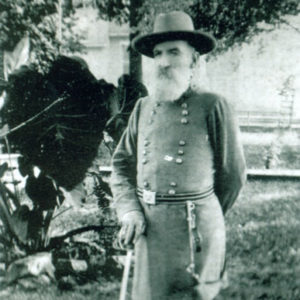calsfoundation@cals.org
Seventh Arkansas Infantry (CS)
The Seventh Arkansas Infantry was a regiment that served in the Confederate army during the American Civil War. Spending most of its service in the Western Theater, the regiment served for the duration of the war.
After Arkansas seceded from the Union on May 6, 1861, military units began to organize across the state. Companies organized in communities and moved to a number of camps to create larger units. Ten companies from northeastern Arkansas organized at Smithville (Lawrence County) into the Seventh Arkansas on June 16, 1861. The companies in the new regiment were from Jackson, Independence, Marion, Izard, Fulton, White, and Randolph counties. The first colonel of the regiment was Robert Shaver, an attorney from Lawrence County. The unit received arms captured at the Federal arsenal in Little Rock (Pulaski County) and was transferred to the eastern bank of the Mississippi River in October.
Stationed at Columbus and Bowling Green, Kentucky, the Seventh Arkansas joined a brigade with two other Arkansas units and a regiment from Tennessee. Shaver commanded the brigade, which served as a rear guard when Bowling Green was evacuated by the Confederates in February 1862. The Confederates retreated to northern Mississippi after the fall of Forts Henry and Donelson, and the regiment transferred to a new brigade. Under the command of Brigadier General Thomas C. Hindman, the brigade contained the Second and Sixth Arkansas Infantry Regiments, as well as the Third Confederate Regiment, which was made up mostly of Arkansans and a battery of Mississippi artillery. Participating in the Battle of Shiloh, the regiment suffered heavy casualties.
Retreating into Mississippi, the Confederates rested and regrouped after the battle. While in Corinth, Mississippi, the unit reorganized and elected new officers. Shaver did not run for reelection and was replaced by his lieutenant colonel, D. A. Gillespie. Brigades were reorganized at the same time, and the Seventh found itself in a mostly Arkansas unit, joining the Second, Fifth, Sixth, and Eighth Arkansas Infantry regiments under the command of Brigadier General St. John Liddell. The single non-Arkansan unit was a battery of Mississippi artillery.
Retreating from Corinth in the face of a massive Federal Army, Liddell’s brigade moved to Chattanooga, Tennessee, and joined a Confederate offensive into Kentucky. The brigade participated in the capture of Munfordville on September 17, 1862, and in the Battle of Perryville on October 8. Failing to take advantage of the momentum gained at these victories, the Confederates retreated to Tennessee. Moving to Triune, the Seventh Arkansas was consolidated with the Sixth Arkansas due to heavy losses at both Shiloh and Perryville. The two regiments served together for the remainder of the war.
The Seventh next saw action at the Battle of Stones River from December 31, 1862, to January 2, 1863, before participating in the Tullahoma Campaign that summer. Liddell’s brigade suffered a defeat at the Battle of Liberty Gap on June 24–25, 1863. Next seeing service in the Chickamauga Campaign, the regiment lost its colonel when Gillespie was wounded and died a few weeks later. Lieutenant Colonel Peter Snyder took command of the regiment and received a promotion to colonel in October. In late 1863, the regiment participated in the Chattanooga Campaign before fighting in the Atlanta Campaign in the summer of 1864. The entire regiment and most of the brigade were captured at the Battle of Jonesboro in Georgia on September 1, 1864.
Exchanged in less than a month, the regiment returned to the Confederate Army of Tennessee and fought in the Nashville Campaign, seeing action at both the battles of Franklin and Nashville, where they took heavy casualties. Colonel Snyder received a wound at Nashville. The last battle that the regiment participated in was at Bentonville, North Carolina, in March 1865. After the battle, the Arkansas units were so depleted that another reorganization took place. The First, Second, Fifth, Sixth, Seventh, Eighth, Thirteenth, Dawson’s Nineteenth, and Twenty-fourth Arkansas Infantry regiments and the Third Confederate Infantry consolidated to form the new First Arkansas Consolidated Infantry.
This unit surrendered with the remainder of the Army of Tennessee on April 26, 1865. Snyder did not surrender with unit, dying on April 19 from typhoid. The survivors of the Seventh Arkansas returned home and reentered civilian life.
For additional information:
Collier, Calvin L. First In—Last Out: The Capitol Guards, Arkansas Brigade. Little Rock: Pioneer Press, 1961.
Noe, Kenneth. Perryville: This Grand Havoc of Battle. Lexington: University Press of Kentucky, 2001.
Walls, Desmond Allen. The Seventh Arkansas Confederate Infantry. Conway: Arkansas Research, 1988.
David Sesser
Henderson State University
 Civil War through Reconstruction, 1861 through 1874
Civil War through Reconstruction, 1861 through 1874 Military
Military 6th and 7th Infantry Regiment Flag
6th and 7th Infantry Regiment Flag  ACWSC Logo
ACWSC Logo  Hardee Pattern Battle Flag
Hardee Pattern Battle Flag  Robert Shaver
Robert Shaver 




Comments
No comments on this entry yet.